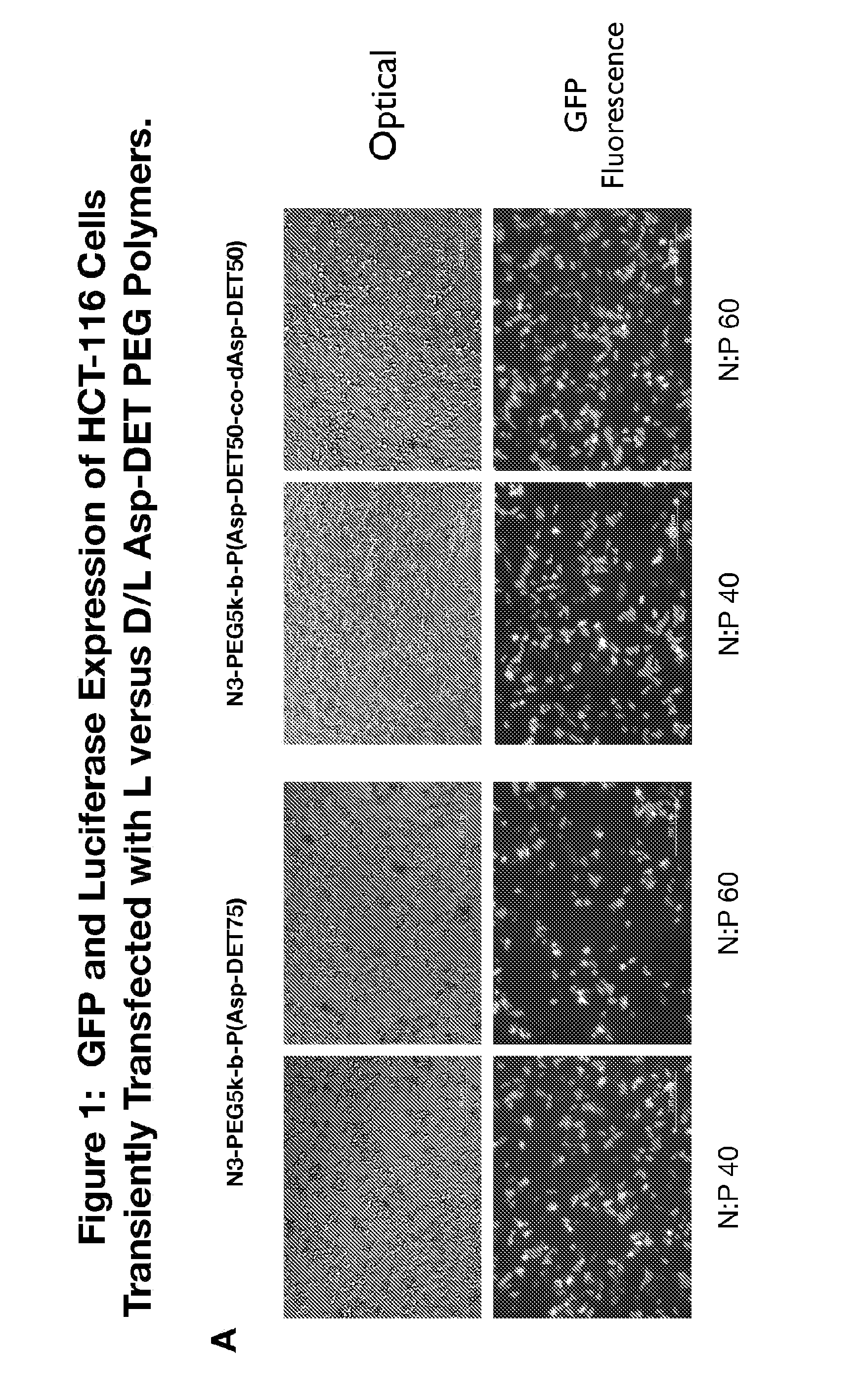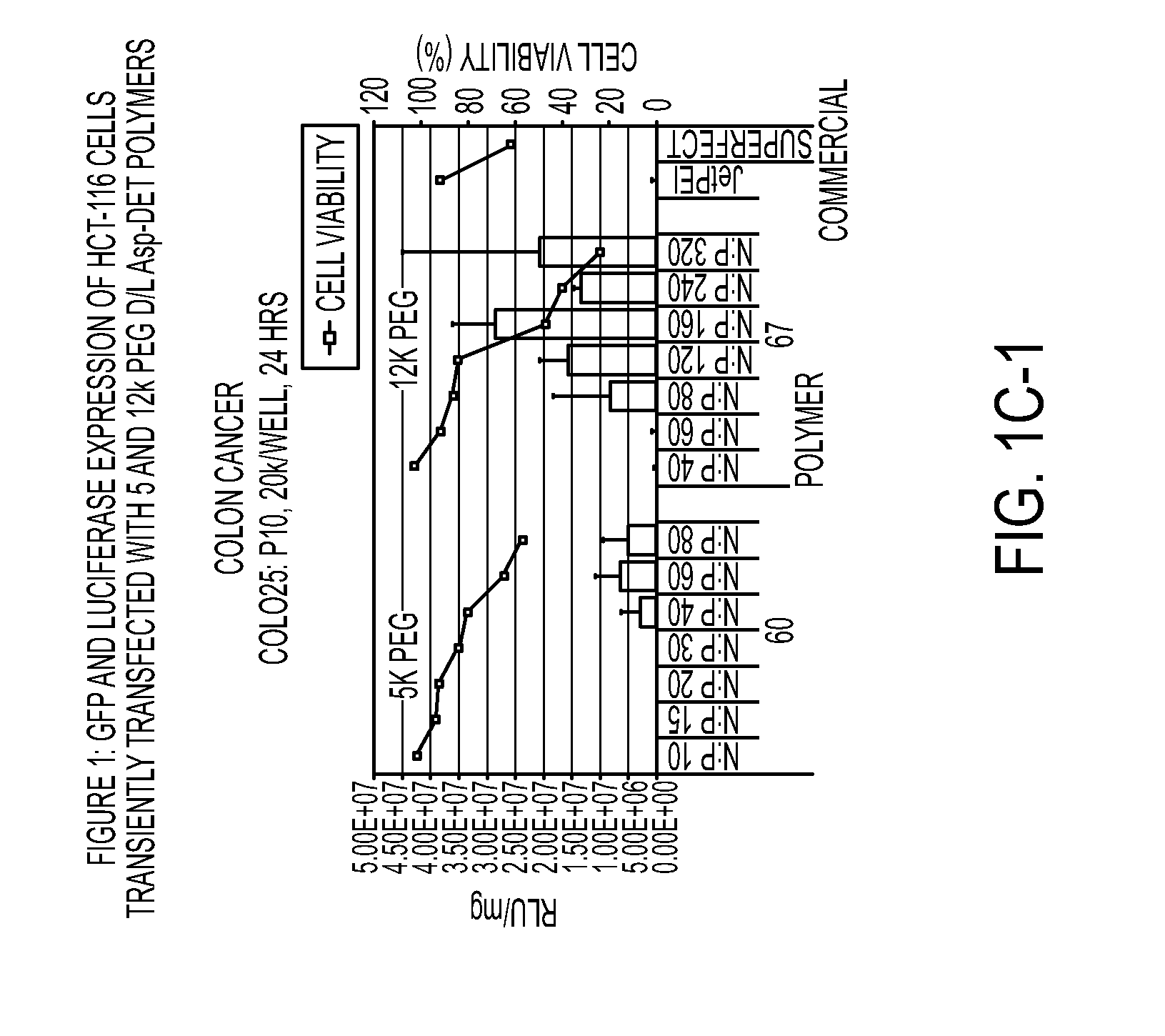Polymeric micelles for polynucleotide encapsulation
a polynucleotide encapsulation and micelle technology, applied in the field of polymer chemistry, can solve the problem of premature dissociation of drug-loaded micelles before active or passive targeting is effectively achieved
- Summary
- Abstract
- Description
- Claims
- Application Information
AI Technical Summary
Benefits of technology
Problems solved by technology
Method used
Image
Examples
example 1
Synthesis of Dibenzyl Amino Ethanol
[0837]
[0838]Benzyl chloride (278.5 g, 2.2 mol), ethanol amine (60 mL, 1 mol), potassium carbonate (283.1 g, 2.05 mol) and ethanol (2 L) were mixed together in a 3 L 3-neck flask, fitted with an overhead stirrer, a condenser and a glass plug. The whole setup was heated up to reflux for 36 hr, after which the insoluble solid was filtered through a medium frit. The filtrate was recovered and ethanol was removed by rotovapor. The viscous liquid was redissolved in ether, the solid suspension removed by filtration and extracted twice against water. The ether solution was kept and the aqueous layer was extracted twice with dichloromethane (2×400 mL). The fraction were recombined, dried over MgSO4, stirred over carbon black for 15 min and filtered through a celite pad. Dichloromethane was removed and the solid was redissolved into a minimal amount of ether (combined volume of 300 mL with the first ether fraction, 300 mL). Hexanes (1700 mL) was added and th...
example 2
Synthesis of (Dibenzyl)-N-EO270-OH
[0839]
[0840]The glassware was assembled while still warm. Vacuum was then applied to the assembly and the ethylene oxide line to about 10 mTorr. The setup was backfilled with argon. 2-Dibenzylamino ethanol (3.741 g, 40.4 mmol) was introduced via the sidearm of the jacketed flask under argon overpressure. Two vacuum / argon backfill cycles were applied to the whole setup. THF line was connected to the 14 / 20 side-arm and vacuum was applied to the whole setup. At this stage, the addition funnel was closed and left under vacuum. THF (4 L) was introduced via the side-arm in the round bottom flask under an argon overpressure. An aliquot of the THF added to the reaction vessel was collected and analyzed by Karl-Fisher colorometric titration to ensure water content of the THF is less than 6 ppm. Next, 2-dibenzylamino ethanol was converted to potassium 2-dibenzylamino ethoxide via addition of potassium naphthalenide (200 mL). Ethylene oxide (500 ml, 10.44 mol)...
example 3
Synthesis of H2N-EO270-OH
[0841]
[0842]Batch Bz-EO270-OH-A (455 g, 39.56 mmol) was split into two equal amounts and was introduced into two 2 L flasks. Batch Bz-EO270-OH—B (273 g, 23.74 mmol) was put into a 2 L flask as well. The following steps were repeated for each flask. H2N-EO270-OH (˜225 g), Pd(OH)2 / C (32 g, 45.6 mmol), ammonium formate (80 g, 1.27 mol) and ethanol (1.2 L) were mixed together in a 2 L flask. The reaction was heated to 80° C. while stirring for 24 hrs. The reaction was cooled to room temperature and filtered through a triple layer Celite / MgSO4 / Celite pad. The MgSO4 powder is fine enough that very little Pd(OH)2 / C permeates through the pad. Celite helps prevent the MgSO4 layer from cracking. At this stage, the three filtrates were combined, precipitated into ˜30 L of ether and filtered through a medium glass frit. The wet polymer was then dissolved into 4 L of water, 1 L of brine and 400 mL of saturated K2CO3 solution. The pH was checked to be ˜11 by pH paper. The...
PUM
| Property | Measurement | Unit |
|---|---|---|
| molecular weights | aaaaa | aaaaa |
| molecular weights | aaaaa | aaaaa |
| mass | aaaaa | aaaaa |
Abstract
Description
Claims
Application Information
 Login to View More
Login to View More - R&D
- Intellectual Property
- Life Sciences
- Materials
- Tech Scout
- Unparalleled Data Quality
- Higher Quality Content
- 60% Fewer Hallucinations
Browse by: Latest US Patents, China's latest patents, Technical Efficacy Thesaurus, Application Domain, Technology Topic, Popular Technical Reports.
© 2025 PatSnap. All rights reserved.Legal|Privacy policy|Modern Slavery Act Transparency Statement|Sitemap|About US| Contact US: help@patsnap.com



